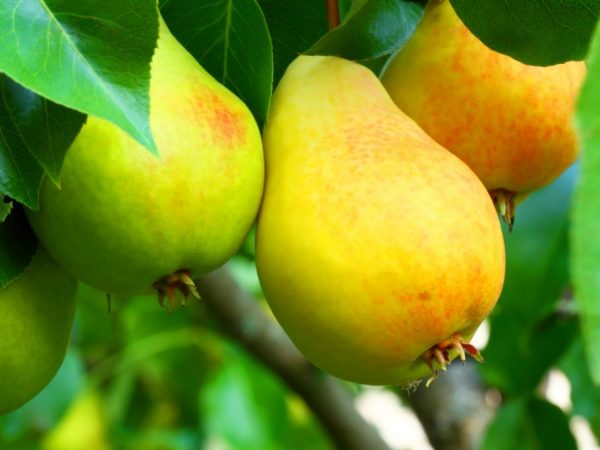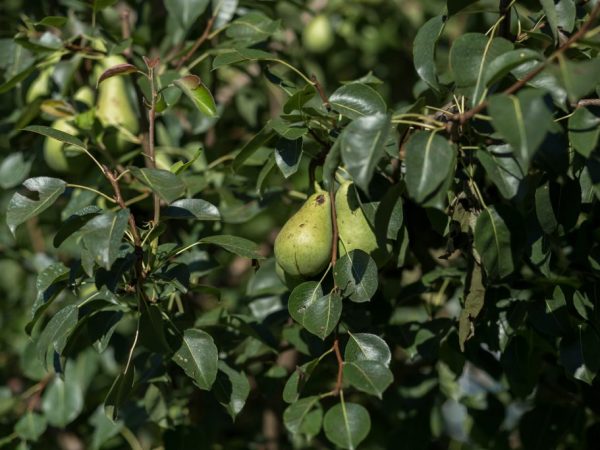Description of pears Zarechnaya
There are many varieties of pear crops. The varieties differ in the time of fruiting, the size and taste of the fruit. A striking representative of summer varieties is the Zarechnaya pear.

Description of pears Zarechnaya
Characteristics of the variety
The Zarechnaya pear variety is a selection, summer or early autumn variety. To breed the variety, a nursery in the Sverdlovsk region at a gardening station was chosen. It was obtained by crossing Tema and Early Milevskaya varieties and quickly gained popularity among gardeners.
Fruiting occurs 4-6 years after planting.
The yield is increasing rapidly. The variety is winter hardy.
Description of the tree
The tree is distinguished by the following features:
- medium height (2.5-3 m);
- fast growing;
- compact;
- the shape of the crown is round, thin, spreading;
- dense foliage.
The crown sags under the weight and fruit. The bark on the trunk is grayish. Skeletal branches of a yellowish tint.
It is characteristic of the variety that young branches are in an inclined vertical position relative to the trunk.
The fruits appear on spears and complex ringlets. The pear blooms in May with white-pink flowers with a pleasant aroma.
Description of fruits and shoots
Shoots appear on the sunny side. Their description:
- color from yellow to olive;
- hairlessness;
- small lentils;
- rare location;
- wedge shape.
The leaves of the Zarechnaya pear are bent downward, slightly elongated, of a beautiful green color. There are no jags or edges on them. The inflorescence is a collection of a large number of flowers, looks like a scutellum.
The beautiful fruits of the Zarechnaya pear weigh up to 140 g.
Description of fruits:
- characteristic pear-shaped shape;
- golden color;
- thin skin;
- the surface is smooth and even;
- the size of the core is average;
- the stalk is thick.
The fruit rests on a stalk of medium length with a small calyx and a cupped pod.
The fruits have a tasty, sweet pulp with a slight sourness. It is juicy, creamy, without any tangible solid inclusions. Fruit weight is 100-120 g.
Ripe pears are removed from the tree from August to mid-September. In some regions, the harvest of fruits is extended until the first decade of October. A characteristic feature is that the fruits do not fall, do not crumble to the ground from the branches after ripening.
Growing pears

Pear yield depends on the quality of care.
The pear culture is unpretentious in cultivation.
To obtain a high yield of pears, Zarechnaya determine the landing site and prepare the pit well. Saplings are chosen for one- or two-year-olds: they take root better than others.
Landing in the soil
The soil for planting should be fertile, with good air permeability. If it is poor in trace elements, it is pre-fertilized. For this, a special nutritional mixture is made from humus, compost and mineral supplements:
- superphosphate - 50 g;
- nitrophoska - 100 g;
- humus - up to 10 kg / sq. m;
- potassium salt - 20-25 g.
Dolmitic flour or ash (2 tbsp.) Is added to acidified soils.
Planting is done in autumn or spring, when sap flow is no longer so intense and there are no frosts on the soil. The pear does not like when it is transplanted from place to place, so the gardener should immediately take into account all the subtleties of planting and the characteristics of the variety.
It is better to prepare the pit in the fall if the landing is planned in the spring. It is made 70 x 70 cm in size, up to 1 m deep. Clay (10-12 cm thick) is poured into the middle of the bottom and sprinkled with compost. Humus is not used in this case. All this is covered with soil mixture and left until spring planting.
If the planting is in the autumn, the hole is dug 3 weeks before. The pillow is made the same as for the spring planting. A peg is placed in the center of the pit, which later serves as a support for the young seedling.
Seedlings undergo pre-planting preparation. They should be grafted, with smooth bark without damage and a vibrant root system. This is the guarantee of the health of the future adult plant. 24 hours before planting, the roots of the plant are soaked in a root stimulant solution. The same water is poured into a prepared hole before planting a seedling.
Lateral and central rhizomes are cut to 12 cm. The trunk should not be higher than 80 cm or contain shoots. They shake it, straighten the roots and set it in a hole, then trample it so that all the air comes out of the earthen lumps, and fill it with water at room temperature. The root collar should rise 4 cm above the soil level.
After that, the soil around is mulched, watered with 2 buckets of water, and the trunk is tied to a peg.
Care
Watering must be monitored, especially during dry periods. With a lack of moisture, the tree sheds its foliage and disappears. Watering should be regular: 1 bucket per week.
For the winter, to avoid frostbite, the tree is covered with burlap or spruce paws. In the northern regions, mature trees are also sheltered. In the spring, the covering material is removed, preventing overheating of the bark, after which measures are taken to combat possible diseases.
The soil is loosened in spring and autumn. Nitrogen fertilizers are applied in early spring, in the first 2-3 years, then every 3-5 years they are fed with organic matter. Mineral fertilizers are applied annually, because the crop takes the substances necessary for development from the tree.
Any fertilizers are applied not at the root, but in the crown zone. They are scattered or buried in shallow grooves.
Diseases
The risk of disease arises from improper care or bad weather conditions. With untimely spraying, fungal or viral diseases appear. Diseases of the pear include scab, stem rot and powdery mildew.
Scab damages the trunk and manifests itself in numerous dots. Stem rot occurs from sunburn or severe frost. White powdery mildew is a fungal disease and can affect the entire plant.
Prophylaxis
Each seedling or adult pear is regularly examined in order to identify the disease in time. Regular pruning and processing of trees helps to keep them healthy and get a good harvest.
Conclusion
Getting a good harvest and growing a Zarechnaya pear on your site is not at all difficult if you follow the rules for planting and caring for trees.


